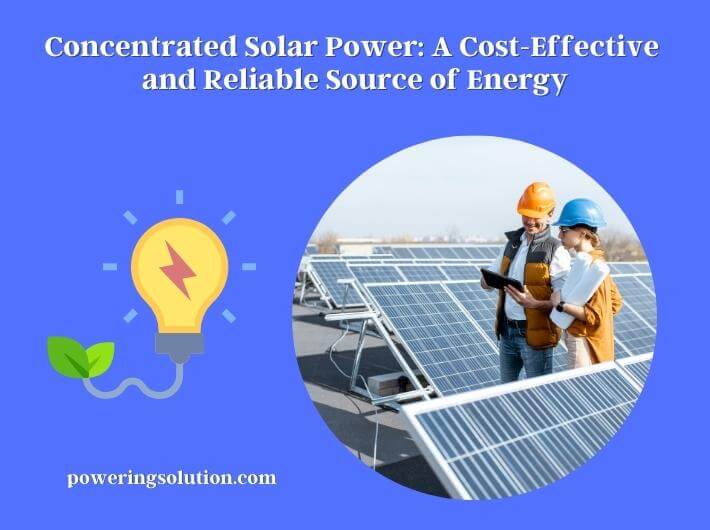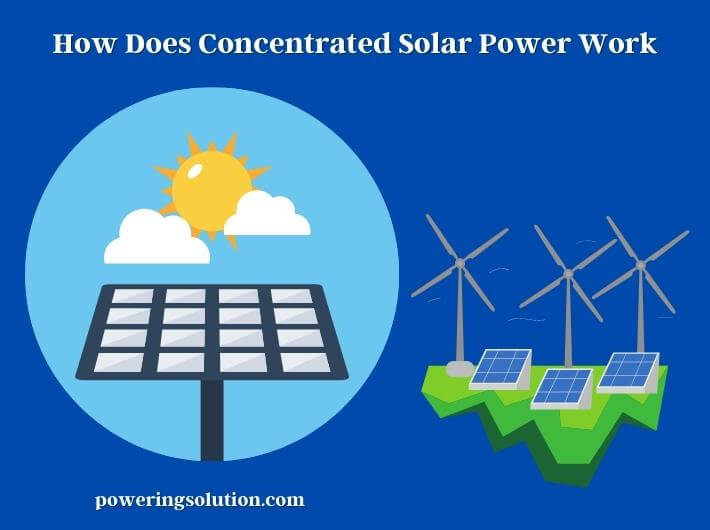Published on: March 6, 2023
Written by Arjo Khan / Fact-checked by Baten Khalil
As the world’s demand for energy continues to grow, the need for clean and renewable sources of power has become increasingly urgent. While there are several options available, one technology that has gained popularity in recent years is Concentrated Solar Power (CSP). CSP is a type of solar energy that uses mirrors or lenses to concentrate sunlight onto a small area, creating heat that can be used to generate electricity.

Unlike photovoltaic (PV) solar panels, which convert sunlight directly into electricity, CSP plants can store energy, making them a reliable source of power even when the sun is not shining.
What is Concentrated Solar Power?
Concentrated Solar Power is a technology that uses mirrors or lenses to concentrate sunlight onto a small area, creating heat that can be used to generate electricity. The concentrated sunlight is used to heat a fluid that produces steam, which drives a turbine that generates electricity. CSP can be used to produce electricity on a large scale, making it a potential solution to the world’s energy needs.
How Does Concentrated Solar Power Work?
Concentrated Solar Power works by using mirrors or lenses to concentrate sunlight onto a small area, creating heat that can be used to generate electricity. The heat is transferred to a fluid, which is used to produce steam. The steam drives a turbine that generates electricity. The process is similar to that used in conventional power plants, except that the heat is generated by sunlight rather than fossil fuels.

Types of Concentrated Solar Power Systems
There are three main types of Concentrated Solar Power (CSP) systems: parabolic troughs, power towers, and dish/engine systems. Each of these systems has unique features and benefits.
Parabolic Troughs
Parabolic troughs are the most widely used CSP technology. The technology uses curved mirrors, called parabolic troughs, to concentrate sunlight onto a receiver tube, which runs along the length of the trough. The receiver tube contains a fluid, such as oil or molten salt, which is heated by concentrated sunlight. The heated fluid is then used to generate steam, which drives a turbine to generate electricity. The parabolic trough system is particularly useful in applications where a large amount of heat is needed, such as in industrial processes.
Power Towers
Power tower CSP systems use a field of mirrors, called heliostats, to reflect sunlight onto a receiver located at the top of a tower. The receiver contains a fluid, such as molten salt or steam, which is heated by concentrated sunlight. The hot fluid is then used to generate steam, which drives a turbine to generate electricity. Power tower CSP systems can achieve higher temperatures than parabolic troughs, making them more efficient. They are particularly useful in applications where a large amount of heat is required, such as in industrial processes.
Dish/Engine Systems
Dish/engine CSP systems use a mirrored dish to concentrate sunlight onto a receiver located at the focal point of the dish. The receiver contains a fluid, such as a hydrogen or helium, which is heated by concentrated sunlight. The hot gas is then used to drive a Stirling engine, which generates electricity. Dish/engine CSP systems are typically used for smaller-scale applications, such as powering individual homes or businesses.
Advantages and Disadvantages of Concentrated Solar Power
Here is a table that summarizes the advantages and disadvantages of Concentrated Solar Power (CSP):
| Advantages | Disadvantages |
| Renewable and abundant energy source | High capital costs for construction and installation |
| Can be used for large-scale electricity generation | Requires large land areas for solar collectors |
| Can be designed with energy storage systems | Can be affected by weather and climate |
| Low operating costs once constructed | Requires water for cooling and cleaning |
| Can reduce greenhouse gas emissions | Can have negative impacts on wildlife and ecosystems |
CSP is a promising technology for generating electricity from renewable sources. It has a number of advantages over traditional fossil fuel sources, including low greenhouse gas emissions, abundant energy supply, and low operating costs. However, CSP also has some disadvantages, such as high capital costs, large land requirements, and the need for water for cooling and cleaning. Despite these challenges, the benefits of CSP make it an important component of the transition to a sustainable energy future.
Concentrated Solar Power vs. Photovoltaic Solar Power
Concentrated Solar Power (CSP) and Photovoltaic Solar Power (PV) are both methods of harnessing the power of the sun to generate electricity. However, they differ in their approach and implementation.
CSP works by using mirrors or lenses to focus sunlight onto a small area, where the heat is absorbed by a working fluid such as molten salt or water, which then drives a turbine to generate electricity. PV, on the other hand, works by converting sunlight directly into electricity through the use of photovoltaic cells.
One of the main differences between CSP and PV is their efficiency. CSP is generally more efficient than PV, with some systems able to achieve efficiencies of up to 50%. This is because CSP can capture and store the heat energy from the sun, allowing it to be used to generate electricity even when the sun is not shining.
Another difference between CSP and PV is their scalability. CSP is well-suited for large-scale electricity generation, as it can be designed with energy storage systems and can generate electricity continuously. PV, on the other hand, is more commonly used for smaller-scale applications, such as residential or commercial rooftop installations.
In terms of cost, PV has become more competitive in recent years, with the cost of PV systems falling rapidly due to advances in technology and manufacturing. CSP, however, still has higher capital costs and requires larger land areas for solar collectors, making it more expensive to install and operate.
Despite their differences, both CSP and PV have their place in the renewable energy landscape. CSP is ideal for large-scale electricity generation, particularly in areas with high levels of solar radiation and low rainfall. PV, on the other hand, is more flexible and can be used in a variety of applications, from small-scale residential installations to large commercial projects. Ultimately, the choice between CSP and PV will depend on a variety of factors, including location, energy needs, and budget.
Applications of Concentrated Solar Power
CSP can be used for a variety of applications, including power generation, heating, and desalination. In power generation, CSP plants can be used to produce electricity on a large scale, making it a potential solution for the world’s energy needs. In heating applications, CSP can be used to provide heat for industrial processes, such as chemical production and food processing. In desalination, CSP can be used to produce fresh water from seawater, making it a potential solution for areas with limited access to fresh water.
Concentrated Solar Power Projects Around the World
There are several large-scale CSP projects around the world, including the Noor Complex in Morocco, which is one of the world’s largest CSP plants, and the Ivanpah Solar Electric Generating System in California, which uses power tower technology to generate electricity. Other large-scale CSP projects include the Shams 1 plant in Abu Dhabi and the Gemasolar plant in Spain.
Future of Concentrated Solar Power
The future of CSP looks promising, with several new projects planned or under construction around the world. The technology is expected to become more cost-effective as the industry scales up and new innovations are introduced. Additionally, advancements in energy storage technology will allow CSP plants to provide reliable power even when the sun is not shining.
How Efficient and Cost-Effective are Power Tower Systems Compared to Concentrated Solar Power?
Power tower systems are highly efficient and cost-effective in comparison to concentrated solar power. The unique design of power tower systems allows for higher temperatures and greater energy production, making them more efficient. Additionally, their modular nature makes them easier and cheaper to scale and maintain, leading to cost-effectiveness.
Conclusion
Concentrated Solar Power is a promising technology that has the potential to provide cost-effective and reliable energy on a large scale. While there are some challenges associated with CSP, such as the need for large amounts of land and consistent sunlight, the technology is becoming more efficient and cost-effective as the industry scales up. With the world’s growing demand for renewable energy sources, CSP is likely to play an important role in meeting our energy needs in the years to come.

